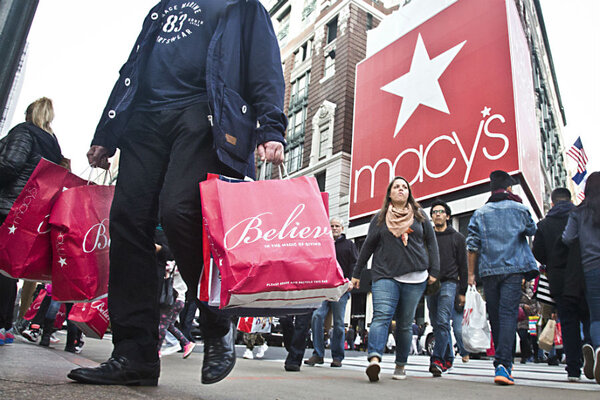Hispanics — or Latinos, a term some prefer — are an attractive market because the population is young and growing at an extraordinarily fast rate. Along with that, spending by Hispanics is growing at a faster clip than for non-Hispanic consumers.
By Juan Castillo,
The Christian Science Monitor, NOVEMBER 22, 2016 —

Shoppers carry bags as they cross a pedestrian walkway near Macy’s in Herald Square, in New York. (AP Photo/Bebeto Matthews, File)
Hispanics in the US have long been known as “the sleeping giant” for their potential as a substantial and still-growing voting bloc. Now, some in the financial services industry are getting serious about targeting Hispanics — and Hispanic millennials in particular — as a prime source for market growth.
Hispanics — or Latinos, a term some prefer — are an attractive market because the population is young and growing at an extraordinarily fast rate. Along with that, spending by Hispanics is growing at a faster clip than for non-Hispanic consumers.
“All of these combine to make a pretty potent formula for growth among Latino consumers,” says Robert Brown, an analyst with Packaged Facts, which released a report in June titled, “Hispanics: Demographics and Consumer Spending Trends.” The report calls Hispanic millennials a key to growth for the financial services industry.
A population defined by its youthfulness
Marketers looking to reach the Hispanic market get a better return on their investment by reaching out to millennials (ages 18 to 36) because they make up an outsize portion of the Hispanic population overall, Brown says.
More than any other group, the nation’s Hispanic population is defined by its youthfulness. One-quarter of all Hispanics in the U.S. are millennials, and nearly 6 in 10 of all Hispanics are under 34, according to the Pew Research Center. Meanwhile, the surging Hispanic population overall, 57 million in 2015, is the nation’s largest minority group, and Hispanics accounted for 54% of all population growth from 2000 to 2014, according to Pew.
Connecting on a cultural level
Financial services marketers are paying attention, says Miriam De Dios, CEO of Coopera, a Des Moines, Iowa-based firm that advises credit unions on how to connect with Latino consumers.
The successful ones have long-term strategies that include having bilingual, bicultural staff and understanding cultural nuances of the market, which is anything but one-size-fits-all, De Dios says.
Hispanic millennials want to see employees who “look like them,” she says, adding, “It’s not enough to say, ‘We want to service this market.’”
Financial institutions need to earn Hispanic millennials’ respect, says Luis Lobo, an executive vice president with BB&T Bank who heads its multicultural markets division. “You enable respect by showing up where the people are,” Lobo says.
BB&T is based in Winston-Salem, North Carolina, where Latino population growth has changed the demographic landscape dramatically. The bank has a Spanish-language website and provides Spanish-language services at its Vecino — Spanish for “neighbor” — financial centers in 12 states and Washington, D.C.
BB&T bankers regularly visit “trusted places” in the community, such as churches, colleges and workplaces, where they meet Hispanic millennials hungry for information on how to make better financial decisions. According to a Hispanic Millennial Project study, 31% of Hispanic millennials say it’s important for a bank to help them understand financial topics, compared with 22% of older Hispanics.
Typically at BB&T community events, a banker presents an instructional video, such as one on how to open a checking account, then opens the floor to questions. The gatherings allow the bank to build trust, Lobo says.
The Packaged Facts study found that Hispanic millennials are more likely to have checking accounts, accounting for 22% of all Hispanics with checking. Non-Hispanic millennials comprised only 14% of non-Hispanic checking account owners.
Not all marketers are sold
Not everyone in the financial services industry is convinced it’s important to market to Hispanic millennials, De Dios says. A common misconception is that younger Hispanics don’t care as much about their culture or language as older Hispanics do.
“There’s this notion, ‘Well, they’re very similar to mainstream millennials. Why do we have to do anything different?’” she says.
Like the Hispanic population overall, Hispanic millennials are not monolithic. Differences can include whether they’re foreign-born or U.S. natives, whether they speak Spanish, English or both, and whether they grew up in households with banking relationships.
Brown, the Packaged Facts demographer, says Hispanic millennials are more likely to have been born in the U.S., speak English and be more acculturated than older Hispanics, who might distrust banks more.
Hispanic millennials might prefer English, but some easily switch between English and Spanish, depending on the situation, De Dios says. Compared with non-Hispanics, Hispanic millennials are more likely to be involved in helping their parents and grandparents meet financial obligations, she adds.
Latino millennials who grew up in unbanked households present special challenges for marketers. Like their parents, they might gravitate toward nonbank options, such as using informal savings and lending circles that are common in immigrant communities.
De Dios, a Mexican immigrant who came to the U.S. when she was a child, grew up in one of those unbanked homes. She was the first in her family to become proficient in English, and she was 9 when she began going with her father to help him cash his paychecks at a neighborhood store. Her father, a construction worker, would then take the cash and buy money orders to pay utility bills and rent.
When he was injured on the job and received a large settlement, the family couldn’t find a bank to cash the check until a friend with a banking account helped.
Being unbanked “was a struggle we all ended up sharing,” De Dios says. “We didn’t know any different.”
A common denominator: Proud of their heritage
For all their differences, Lobo says, Hispanic millennials share a common trait: They are proud of their heritage, whether they were born in the U.S. or not.
Lobo, a Costa Rican immigrant, counts his children, ages 23 and 26, among those who hold culture close to heart. Born in the U.S., they don’t speak Spanish and are “digital natives,” Lobo says. That’s consistent with research showing that Hispanic millennials are tech-savvy and more apt to use smartphones and mobile banking than the general population.
But digital alone isn’t the answer. “It is the complement to being physically present,” Lobo says.
De Dios says financial institutions would do well to consider Latino millennials as a lifeline to the future. With the median age of a credit union customer approaching 50, she says, “Credit unions need to be reaching out to this young market that represents a lot of growth opportunities for them.”
This story originally appeared on NerdWallet .










